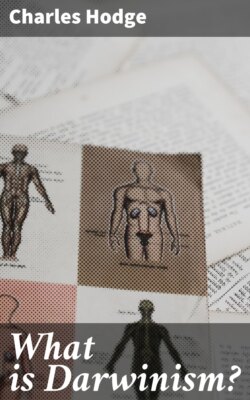Читать книгу What is Darwinism? - Charles Russell Hodge - Страница 13
На сайте Литреса книга снята с продажи.
Mr. Darwin's Theory.
ОглавлениеTable of Contents
We have not forgotten Mr. Darwin. It seemed desirable, in order to understand his theory, to see its relation to other theories of the universe and its phenomena, with which it is more or less connected. His work on the "Origin of Species" does not purport to be philosophical. In this aspect it is very different from the cognate works of Mr. Spencer. Darwin does not speculate on the origin of the universe, on the nature of matter, or of force. He is simply a naturalist, a careful and laborious observer; skillful in his descriptions, and singularly candid in dealing with the difficulties in the way of his peculiar doctrine. He set before himself a single problem, namely, How are the fauna and flora of our earth to be accounted for? In the solution of this problem, he assumes:—
1. The existence of matter, although he says little on the subject. Its existence however, as a real entity, is everywhere taken for granted.
2. He assumes the efficiency of physical causes, showing no disposition to resolve them into mind-force, or into the efficiency of the First Cause.
3. He assumes also the existence of life in the form of one or more primordial germs. He does not adopt the theory of spontaneous generation. What life is he does not attempt to explain, further than to quote (p. 326), with approbation, the definition of Herbert Spencer, who says, "Life depends on, or consists in, the incessant action and reaction of various forces,"—which conveys no very definite idea.
4. To account for the existence of matter and life, Mr. Darwin admits a Creator. This is done explicitly and repeatedly. Nothing, however, is said of the nature of the Creator and of his relation to the world, further than is implied in the meaning of the word.
5. From the primordial germ or germs (Mr. Darwin seems to have settled down to the assumption of only one primordial germ), all living organisms, vegetable and animal, including man, on our globe, through all the stages of its history, have descended.
6. As growth, organization, and reproduction are the functions of physical life, as soon as the primordial germ began to live, it began to grow, to fashion organs however simple, for its nourishment and increase, and for the reproduction, in some way, of living forms like itself. How all living things on earth, including the endless variety of plants, and all the diversity of animals—insects, fishes, birds, the ichthyosaurus, the mastodon, the mammoth, and man—have descended from the primordial animalcule, he thinks, may be accounted for by the operation of the following natural laws, viz.:—
First, the law of Heredity, or that by which like begets like. The offspring are like the parent.
Second, the law of Variation, that is, while the offspring are, in all essential characteristics, like their immediate progenitor, they nevertheless vary more or less within narrow limits, from their parent and from each other. Some of these variations are indifferent, some deteriorations, some improvements, that is, they are such as enable the plant or animal to exercise its functions to greater advantage.
Third, the law of Over Production. All plants and animals tend to increase in a geometrical ratio; and therefore tend to overrun enormously the means of support. If all the seeds of a plant, all the spawn of a fish, were to arrive at maturity, in a very short time the world could not contain them. Hence of necessity arises a struggle for life. Only a few of the myriads born can possibly live.
Fourth, here comes in the law of Natural Selection, or the Survival of the Fittest. That is, if any individual of a given species of plant or animal happens to have a slight deviation from the normal type, favorable to its success in the struggle for life, it will survive. This variation, by the law of heredity, will be transmitted to its offspring, and by them again to theirs. Soon these favored ones gain the ascendency, and the less favored perish; and the modification becomes established in the species. After a time another and another of such favorable variations occur, with like results. Thus very gradually, great changes of structure are introduced, and not only species, but genera, families, and orders in the vegetable and animal world, are produced. Mr. Darwin says he can set no limit to the changes of structure, habits, instincts, and intelligence, which these simple laws in the course of millions or milliards of centuries may bring into existence. He says, "we cannot comprehend what the figures 60,000,000 really imply, and during this, or perhaps a longer roll of years, the land and waters have everywhere teemed with living creatures, all exposed to the struggle for life, and undergoing change." (p. 354). "Mr. Croll," he tells us, "estimates that about sixty millions of years have elapsed since the Cambrian period, but this, judging from the small amount of organic change since the commencement of the glacial period, seems a very short time for the many and the great mutations of life, which have certainly occurred since the Cambrian formation; and the previous one hundred and forty million years can hardly be considered as sufficient for the development of the varied forms of life which certainly existed toward the close of the Cambrian period." (p. 379). Years in this connection have no meaning. We might as well try to give the distance of the fixed stars in inches. As astronomers are obliged to take the diameter of the earth's orbit as the unit of space, so Darwinians are obliged to take a geological cycle as their unit of duration.
